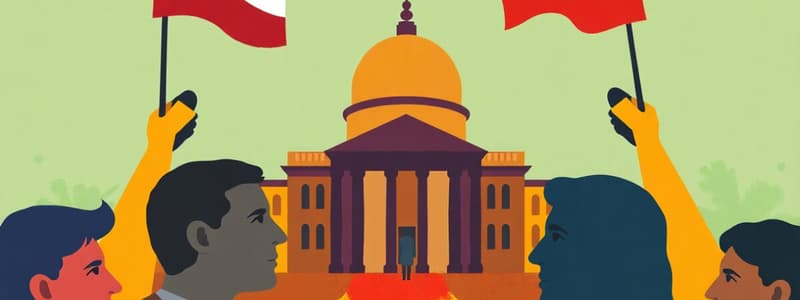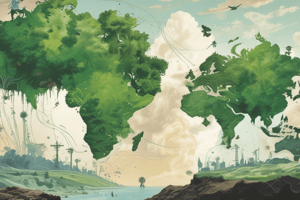Podcast
Questions and Answers
Which of the following is NOT a factor that influences voting behavior?
Which of the following is NOT a factor that influences voting behavior?
- Socioeconomic status
- Individual evaluation of candidates
- Demographic characteristics
- Weather patterns on election day (correct)
Voter apathy typically increases voter turnout.
Voter apathy typically increases voter turnout.
False (B)
Journalists act as ______ of information, presenting filtered news.
Journalists act as ______ of information, presenting filtered news.
gatekeepers
How can media bias impact public perception?
How can media bias impact public perception?
Match the terms with their descriptions:
Match the terms with their descriptions:
What is the primary purpose of an electoral system?
What is the primary purpose of an electoral system?
In a majoritarian system, seats are allocated proportionally to the votes received by parties.
In a majoritarian system, seats are allocated proportionally to the votes received by parties.
Name two key elements of a democratic system of government.
Name two key elements of a democratic system of government.
A system of government where supreme power is vested in the people is known as a ______.
A system of government where supreme power is vested in the people is known as a ______.
What is the main function of political parties?
What is the main function of political parties?
One-party systems are marked by strong competition between various political groups.
One-party systems are marked by strong competition between various political groups.
Match the following with their descriptions:
Match the following with their descriptions:
Give two examples of citizen participation in a democracy.
Give two examples of citizen participation in a democracy.
Flashcards
What is politics?
What is politics?
The process of making and implementing decisions that affect a society or its members. This includes activities like campaigning, lobbying, and policymaking.
What is democracy?
What is democracy?
A system of government where supreme power is vested in the people and exercised by them directly or indirectly through a system of representation, typically involving periodic free and fair elections.
What is citizen participation?
What is citizen participation?
Active involvement of citizens in political processes, ranging from voting to activism and lobbying.
What is an electoral system?
What is an electoral system?
Signup and view all the flashcards
What are political parties?
What are political parties?
Signup and view all the flashcards
What are party systems?
What are party systems?
Signup and view all the flashcards
What is proportional representation?
What is proportional representation?
Signup and view all the flashcards
What are majoritarian systems?
What are majoritarian systems?
Signup and view all the flashcards
Demographic Factors in Voting
Demographic Factors in Voting
Signup and view all the flashcards
Voter Turnout
Voter Turnout
Signup and view all the flashcards
Electoral Trends
Electoral Trends
Signup and view all the flashcards
Impact of Media on Public Opinion
Impact of Media on Public Opinion
Signup and view all the flashcards
Media Bias
Media Bias
Signup and view all the flashcards
Study Notes
Politics
- The process of making and implementing decisions affecting a society or its members.
- Activities include campaigning, lobbying, and policymaking.
- Includes various institutions like governments, legislatures, and political parties.
Democracy and Participation
- Democracy: A system of government where supreme power is vested in the people.
- Exercised directly or indirectly through representation, typically involving periodic free and fair elections.
- Key elements include citizen participation, protection of human rights, and the rule of law.
- Citizen Participation: Active involvement in political processes, from voting to activism and lobbying.
- Varied based on education, socioeconomic status, and political interest.
- Increased participation often associated with stronger democracies.
- Forms of Participation: Direct democracy (referendums, initiatives), representative democracy (voting for representatives).
- Other forms include civil society engagement and protest movements.
Electoral Systems
- Electoral Systems: Rules regulating the process of electing representatives.
- Vote-counting method significantly affects the makeup of the representative body.
- Types of Systems: Proportional representation (PR) allocates seats proportionally to votes.
- Majoritarian systems (e.g., first-past-the-post) elect the candidate with the most votes in a district.
- Effects of Electoral Systems: Varying outcomes impact representation, party structures, and political stability.
- PR often leads to multi-party systems; majoritarian systems often lead to two-party dominance.
Political Parties
- Political Parties: Groups contesting elections and holding government power.
- Advocate for specific policies and ideologies.
- Functions of Parties: Recruiting candidates, formulating policy platforms, mobilizing voters, organizing government activity.
- Promote stability and provide a channel for citizen participation.
- Party Systems: Describe the number and strength of political parties in a country.
- Common structures include one-party, two-party, and multi-party systems.
Voting Behaviour
- Factors Influencing Voting: Demographic factors (age, gender, ethnicity), socioeconomic status, education, ideology, current issues.
- Individual evaluation of candidates and party platforms also affect choices.
- Voter Turnout: Percentage of eligible voters casting ballots.
- Factors increasing turnout include strong voter registration, easy access, and high political interest.
- Apathy and voter suppression can decrease turnout.
- Electoral Trends: Patterns in voting over time, including shifts in party preference and generational changes.
- Understanding evolving societal values and political landscapes.
The Media
- Role of the Media: Reporting events, informing the public, shaping public opinion.
- Journalists act as gatekeepers of information, filtering and presenting news.
- Media Bias: Different media outlets can exhibit bias.
- Political leaning or financial influence can affect information presentation.
- Recognizing potential bias is crucial for informed citizenry.
- Media and Political Campaigns: Crucial component, disseminating information about candidates and policies.
- Social media platforms are transforming campaign communication.
- Impact of Media on Public Opinion: The media's portrayal significantly influences the electorate's perceptions and decisions in elections.
Studying That Suits You
Use AI to generate personalized quizzes and flashcards to suit your learning preferences.




